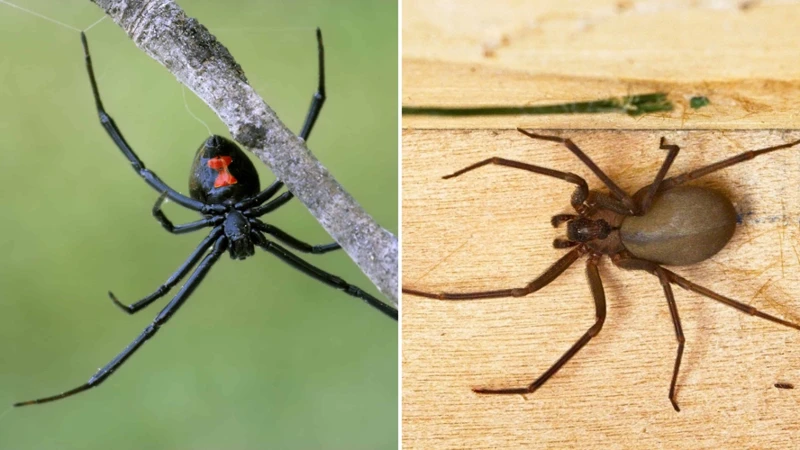As humans, we have an aversion to creepy crawlies, especially spiders. However, some spiders pose a greater risk to our health than others. Two commonly mistaken spiders, the Black Widow Spider and the Brown Recluse Spider, are known for their venomous bites that can lead to severe symptoms. In this article, we’ll explore the differences between these two spiders, including their appearance, habitats, bite symptoms, treatments, and prevention methods. By understanding these differences, you can better protect yourself from potential spider encounters and their negative consequences. So let’s dive into the world of Black Widow Spiders and Brown Recluse Spiders and learn how to differentiate between these dangerous arachnids.
Appearance
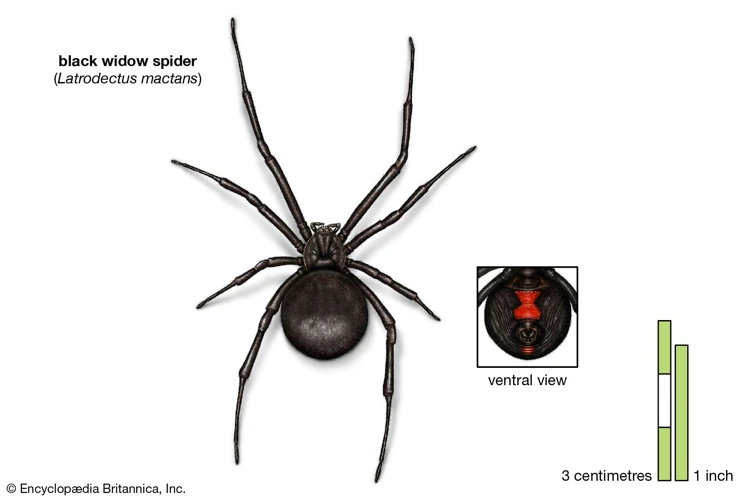
The way a spider looks can provide valuable clues about its species and behavior. Both the Black Widow Spider and the Brown Recluse Spider have distinct physical characteristics that set them apart from one another. Understanding the differences in their appearance can help people identify and avoid them. The Black Widow Spider and Brown Recluse Spider differ not only in terms of size, but also color, eyes, and fangs. Let’s explore these differences in more detail. For further information regarding the anatomy of a Black Widow Spider, click on this link.
Black Widow Spider
When it comes to appearance, the black widow spider is easily identifiable. Its body is shiny and black, with a distinctive red hourglass-shaped marking on the underside of its abdomen. The females are larger than the males, with the females measuring up to 1.5 inches (including leg span) while males have a smaller body size. They have eight legs and two body segments, similar to other arachnids.
Black Widow Spider Bite Symptoms: A bite from a black widow spider can be quite painful and may result in several symptoms within a few minutes to an hour after the bite. Symptoms typically include a sharp pain in the bitten area, muscle cramps or spasms, sweating, difficulty breathing, and abdominal pain. The venom affects the nervous system, and in some cases, can cause paralysis. Some people may also experience a severe allergic reaction, which could lead to anaphylactic shock and could be life-threatening.
To know more about the effects of the venom on the body and the brain, you can read our article on “The Brain Effects of Black Widow Venom”. The symptoms can persist for several days but will eventually resolve on their own.
Black Widow Spider Habitat: The black widow spider can be found in various parts of the world, but it is most commonly found in warmer regions such as the southern and western states of the United States, as well as in South America, Africa, and Southern Europe. The black widow spider likes to create webs in dark, cool areas such as basements, woodpiles, and crawl spaces.
It is highly recommended to take adequate precautions when exploring such areas during the warm seasons when these spiders are most commonly active. To learn more about how to avoid black widow spider bites in the house or garden, check out our article on “How to Avoid Black Widow Spider Bites in the House or Garden”.
Black Widow Spider Treatment: If you suspect that you have been bitten by a black widow spider, it is important to seek medical attention immediately. Treatment may include administering antivenom and other medications to relieve the symptoms. It is also recommended to apply ice to the bitten area and elevate the affected limb to reduce pain and swelling.
To learn more about the treatment for black widow spider bites and how it compares to other venomous spider bites, please read our article on “Black Widow Spider Bites vs. Other Venomous Spider Bites”.
Black Widow Spider Prevention: As the old adage goes, prevention is better than cure. Avoid disturbing areas where black widow spiders may reside and ensure to keep your house and garden free of clutter. It is important to wear proper clothing and gloves when handling items or moving objects in areas where black widows are likely present.
To know more about the geographical distribution of black widow spiders and ways to avoid bites, please read our article on “Black Widow Globally and How to Deal With Them Safely”.
The black widow spider is one of the most well-known venomous spiders in the world. Understanding the differences between the black widow spider and other venomous spiders can be helpful in identifying and treating bites. It is important to take precautions when dealing with spider bites, and seek medical attention if necessary.
Brown Recluse Spider
The brown recluse spider is also known as the fiddleback spider because of its brown color and violin-shaped thorax. It is one of the most venomous spiders in North America. The venom is cytotoxic, which means that it destroys cells, tissues, and organs and causes a range of symptoms.
Appearance: The brown recluse spider has a light brown color and a dark mark on its back, which is often described as a violin or fiddle shape. The spider is approximately 0.5 inch long and has long, thin legs. Its body is covered with short hairs, and it has six eyes arranged in pairs.
Habitat: The brown recluse spider is commonly found in the south-central and Midwestern United States. It prefers warm, dry environments and can be found in dark, undisturbed areas such as closets, basements, and attics.
Bite symptoms: The brown recluse spider bite can be painless or cause a mild stinging sensation followed by intense pain. The bite site may become red and swollen and may develop a bullseye pattern. The venom can cause necrosis (tissue death) which can lead to an open ulcer that oozes fluid and forms a scab, which can take longer than six weeks to heal. Brown recluse spider bites can also cause fever, chills, muscle aches, and nausea.
Treatment: If bitten by a brown recluse spider, seek medical attention immediately. The wound should be cleaned and a tetanus shot may be necessary. Treatment may include pain management, antibiotics to prevent infection, and in some cases, surgery to remove dead tissue.
Prevention: To prevent brown recluse spider bites, it is important to keep living and workspaces neat and organized, as they prefer undisturbed areas. Wear protective clothing when handling boxes or working in attics and basements. If you suspect a brown recluse spider infestation, contact a licensed pest control operator.
While both the black widow and brown recluse spiders are venomous and potentially harmful to humans, it is important to understand the differences in their appearance, habitat, bite symptoms, and treatment. If you come in contact with either of these spiders, seek medical attention immediately.
Habitat
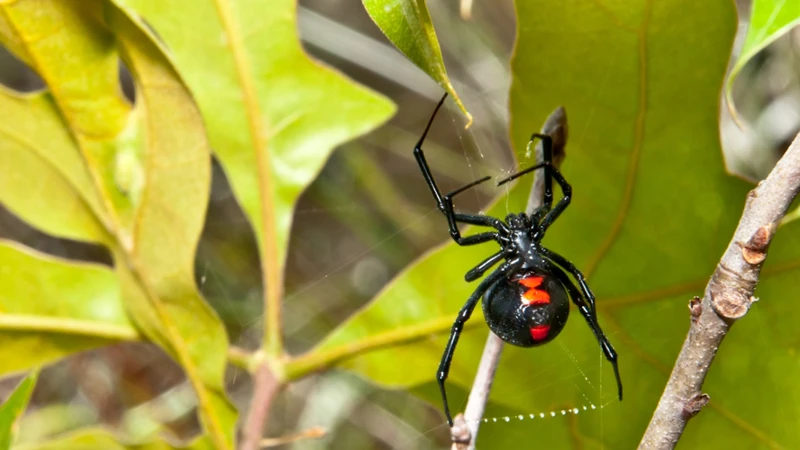
The habitat of the Black Widow Spider and the Brown Recluse Spider differs in certain aspects. Black Widow Spiders are commonly found in warm climates such as the southern and western parts of the United States, while Brown Recluse Spiders are primarily found in the central and southeastern parts of the country. Black Widow Spiders usually prefer areas that are dark and hidden, such as wood piles, sheds, and garages, while Brown Recluse Spiders tend to hide in dark and quiet places, such as closets, attics, and basements.
Black Widow Spiders are also known to make their webs in outdoor areas such as around bushes, trees, and rocks. These spiders prefer to build their webs at a height of around 3-8 feet above the ground. Interestingly, Black Widow Spiders may build several webs if the old one becomes damaged or infested with parasites.
On the other hand, Brown Recluse Spiders often build their irregular webs in undisturbed areas such as cluttered and dark corners. It’s common for them to inhabit stacks of boxes, under furniture, and inside clothing left on the floor. Since Brown Recluse Spiders are primarily nocturnal, they usually come out at night to search for prey or when disturbed by movement near their hiding places.
It’s also worth noting that both these spiders can be found in outdoor and indoor areas such as barns, outside restrooms, and storage buildings. It’s important to be cautious and keep an eye out when venturing into any of these areas.
Understanding the habitat of these spiders can help individuals take preventive measures, such as not leaving clothes or shoes on the floor, storing items in plastic containers, and wearing protective clothing when gardening or handling firewood in outdoor areas. By taking necessary precautions, individuals can decrease their chances of encountering these venomous spiders and avoid the harmful effects of their bites.
Bite Symptoms
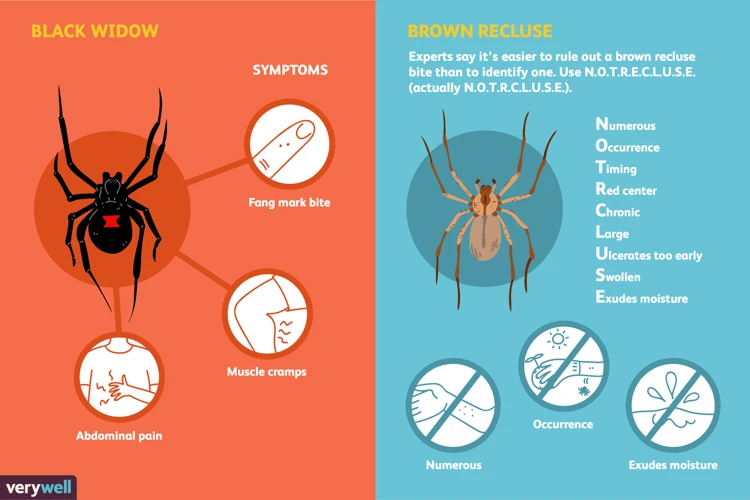
The effects of spider bites can range from mild irritation to severe health problems. Knowing the symptoms of bites from a black widow and a brown recluse spider can help you seek medical attention promptly. While some symptoms may be similar, there are also distinct differences to consider. Understanding these differences can be crucial in assisting with proper diagnosis and treatment. Let’s take a closer look at the bite symptoms of these two spiders.
Black Widow Spider
The Black Widow Spider is notorious for its dangerous reputation and distinct appearance. Here are some key facts to help you understand the Black Widow Spider:
- Appearance: Females have a shiny black body with a red hourglass-shaped mark on the underside, while males are smaller and lighter in color. The female’s venomous bite and striking appearance serves to ward off potential predators. For more information on Black Widow Spider’s life cycle and venom, check out our article on black widow spider life cycle and venom.
- Habitat: Black Widow Spiders prefer warm, dark, and dry environments such as garages, dark corners of basements, and cluttered debris that provide shelter. They are commonly found in the southern regions of the United States.
- Bite Symptoms: If you are bitten by a Black Widow Spider, it may feel like a pinprick. Within an hour, you may experience muscle spasms, abdominal pain, and difficulty breathing. For more information on the immune system’s reaction to Black Widow Spider bites, read our article on immune system response to black widow spider bites
- Treatment: If you suspect a Black Widow Spider bite, seek medical attention immediately. Treatment may include pain relievers, muscle relaxants, and antivenom medication. For more information on how the venom of this spider works, you can read our article on black widow venom chemistry and its evolutionary significance.
- Prevention: The best way to prevent a Black Widow Spider infestation is by keeping your home and surroundings clean, well-organized, and free from clutter. Wear gloves when working in areas where these spiders are known to frequent and seal any cracks or crevices in your home where spiders could enter. For more information on potential health risks associated with Black Widow Spider bites, read our article on health risks of black widow spider bites.
Understanding the differences between the Black Widow Spider and other venomous spiders such as the Brown Recluse Spider is essential in keeping you and your loved ones safe from harm.
Brown Recluse Spider
The brown recluse spider, also known as the violin spider or brown fiddler, is a venomous spider native to the southern region of the United States. Here are some key features and facts about this spider:
- Physical Appearance: The brown recluse spider is light to medium brown in color, with a characteristic violin-shaped marking on its head and thorax. This marking is often the easiest way to identify the spider, but not all brown recluse spiders have it. They have six eyes arranged in pairs, unlike most spiders which have eight eyes. Their bodies are about the size of a quarter, but their long legs can give them a larger appearance.
- Habitat: Brown recluse spiders typically live in quiet, dry, undisturbed areas such as closets, woodpiles, and dark spaces in attics or basements. They are rarely found out in the open and prefer to come out at night.
- Bite Symptoms: Brown recluse spider bites can cause a range of symptoms depending on the severity of the bite and the individual’s reaction to the venom. Initially, the bite may not be felt or even noticed. Over time, the affected area may become red, swollen, and tender. The venom can destroy skin tissue and create a deep, open sore that can take several months to heal. In severe cases, the venom can cause fever, chills, and even seizures.
- Treatment: If bitten by a brown recluse spider, it is important to seek medical attention immediately. Treatment may involve cleaning the wound and applying antibiotics to prevent infection. More severe cases may require surgery to remove dead tissue and promote healing.
- Prevention: To prevent encountering a brown recluse spider, it is important to keep your living spaces clean, clutter-free, and well-lit. Seal cracks and crevices in your home to prevent spiders from entering. If you live in an area where brown recluse spiders are common, wear gloves and long sleeves when working outside or in dark spaces.
It is important to exercise caution and awareness around brown recluse spiders, as their bites can cause serious health issues. If you suspect you have been bitten, seek medical attention immediately.
Treatment
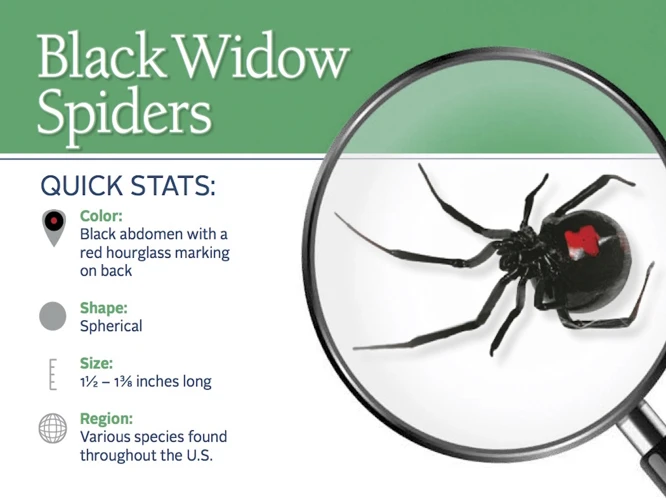
Handling the aftermath of a spider bite is crucial. The appropriate treatment should be administered as soon as possible. Seek immediate medical attention upon noticing any symptoms of a spider bite. Treating spider bites may vary from one species to another. Understanding the right treatment for a black widow spider and brown recluse spider bite is essential in managing their venomous bites.
Black Widow Spider
The Black Widow Spider is known for its distinctive appearance and venomous bite. Here are some key characteristics of this particular spider:
| Color: | Black or dark brown with a red or orange hourglass shape on its abdomen |
| Size: | Approximately 1.5 inches long, including legs |
| Web: | Their webs are strong and sticky, often found in dark, enclosed spaces like garages, woodpiles, and outdoor toilets |
| Bite Symptoms: | Initial bite may feel like a pinprick, but symptoms can include muscle pain, cramps, spasms, and nausea. Symptoms may take hours or even days to develop, but seeking medical attention is crucial |
It’s important to note that while the Black Widow’s venom is potent, bites are rarely fatal if given proper medical attention. Prevention is key when dealing with Black Widow Spiders, as avoiding their habitats can greatly reduce the risk of being bitten.
Brown Recluse Spider
The Brown Recluse Spider, also known as the violin spider, is a venomous spider found predominantly in the central and southern parts of the United States. Here are some important things to know about this spider:
- Identification: Brown Recluse Spiders are light to dark brown in color and have a distinct violin-shaped marking on their backs. They also have long, thin legs with fine hairs.
- Habitat: These spiders can typically be found in dark, sheltered areas such as closets, crawl spaces, basements, and attics. They often build their webs in corners or behind objects.
- Bite Symptoms: Brown Recluse Spider bites can cause a range of symptoms, including itching, pain, redness, and swelling at the bite site. Within a few hours, a blister may form and the surrounding tissue may become discolored. In severe cases, the venom can cause necrosis, or death of the skin tissue, which can result in scarring and in some cases, even loss of limb function.
- Treatment: If you suspect you have been bitten by a Brown Recluse Spider, it’s important to seek medical attention immediately. Treatment may include antibiotics to prevent infection, pain medications, and in severe cases, surgical intervention to remove dead tissue.
- Prevention: To prevent Brown Recluse Spider infestations, it’s important to keep your home clean and clutter-free. Seal up cracks and crevices in your home, pay attention to areas where the spider may have set up their web, and keep clothing and other items off of the floor.
It’s important to exercise caution around the Brown Recluse Spider and take appropriate measures to prevent bites. If you are bitten, seek medical attention immediately to ensure proper treatment and prevent potential complications.
Prevention
One of the most effective ways to protect yourself from both black widow and brown recluse spiders is to take preventive measures in and around your home. Here are some tips to lessen the chances of having these venomous spiders on your property and encountering them:
1. Keep your outdoor space clean and tidy: Regularly clean up your yard, garden, and surrounding areas. Make sure to remove debris, piles of leaves, and other clutter where spiders may hide. Trim bushes and trees to prevent spiders from making webs and hiding in the branches.
2. Seal cracks and gaps: Check your home’s exterior for cracks, gaps, and holes. Seal them up using caulk or weather stripping to prevent spiders from entering and creating nests inside.
3. Use spider repellents: There are several safe and effective spider repellents available on the market. Use them around your home’s perimeter, particularly near doors and windows.
4. Keep food in airtight containers: Spiders are attracted to food, so make sure to store it in airtight containers to reduce the possibility of spider infestations in your home.
5. Regularly dust and vacuum: Spider webs tend to accumulate in hidden areas, so make it a habit to regularly dust and vacuum your home, paying special attention to corners, baseboards, and behind furniture.
By taking these preventive measures, you can significantly reduce the likelihood of encountering black widows or brown recluse spiders in your home or backyard. It is always a good idea to consult with a professional pest control service if you suspect a spider infestation in your home or if you have been bitten by either of these venomous spiders.
Conclusion
After understanding the differences between the Black Widow spider and the Brown Recluse spider, it is crucial to take necessary precautions to avoid bites from these venomous arachnids. One must always keep their surroundings clean, free of clutter, and well-lit to avoid creating a perfect habitat for these spiders. Wearing protective clothing, gloves, and shoes while in the garden or near wooded areas can offer additional protection against spider bites.
In case of a spider bite, it is crucial to identify the type of spider involved and seek immediate medical attention. Early detection and treatment are crucial to minimize the potentially serious or deadly effects of spider venom. Keeping antivenom medications on hand in high-risk areas can also be beneficial.
Overall, knowledge and caution are the best defenses against spider bites. By understanding the differences between the Black Widow spider and Brown Recluse spider, their habitats, and the symptoms of their bites, we can take necessary measures to avoid bites and seek prompt medical attention if bitten. With these precautions, we can stay safe and prevent any potential harm caused by these venomous spiders.
Frequently Asked Questions
What do black widow spiders look like?
Black widow spiders are shiny black with a distinctive red hourglass-shaped marking on their abdomen.
What do brown recluse spiders look like?
Brown recluse spiders are light to dark brown with a distinctive violin-shaped marking on their cephalothorax.
Where are black widow spiders commonly found?
Black widow spiders are commonly found in the southern regions of the United States, particularly in warmer areas like Florida and California.
Where are brown recluse spiders commonly found?
Brown recluse spiders are commonly found in the central and southern regions of the United States, particularly in states like Oklahoma, Arkansas, and Missouri.
What are the symptoms of a black widow spider bite?
Symptoms of a black widow spider bite include muscle pain, spasms, and cramps in the affected area, as well as nausea, vomiting, and difficulty breathing.
What are the symptoms of a brown recluse spider bite?
Symptoms of a brown recluse spider bite include a red, itchy area that may develop into a blister, as well as fever, chills, and body aches.
What should I do if I think I’ve been bitten by a black widow spider?
If you think you’ve been bitten by a black widow spider, seek medical attention immediately. Applying a cold compress to the affected area can help ease pain and swelling in the meantime.
What should I do if I think I’ve been bitten by a brown recluse spider?
If you think you’ve been bitten by a brown recluse spider, seek medical attention immediately. Elevating the affected area and applying a cold compress can also help ease symptoms.
How can I prevent black widow spider infestations?
To prevent black widow spider infestations, keep your home and yard clean and clutter-free, seal up cracks and holes in buildings, and use insecticides if necessary. Wear gloves when working outside or in areas where black widow spiders may be present.
How can I prevent brown recluse spider infestations?
To prevent brown recluse spider infestations, keep your home and yard clean and clutter-free, seal up cracks and holes in buildings, and use insecticides if necessary. Avoid leaving clothing or shoes on the floor, as these spiders like to hide in dark, secluded areas.

